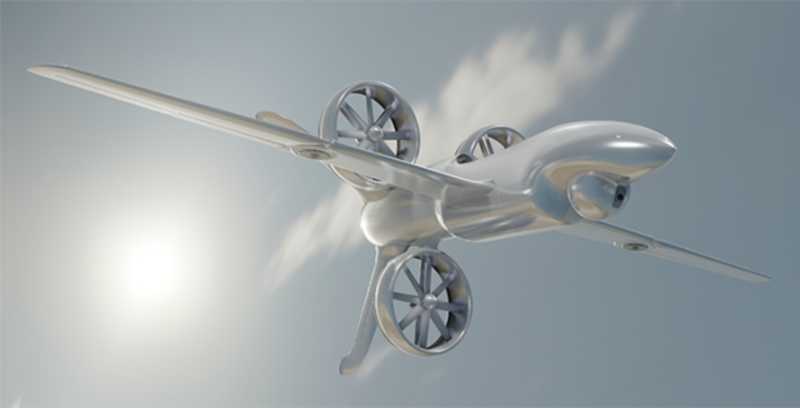The U.S. Defense Advanced Research Projects Agency (DARPA) recently announced it had selected nine companies to move forward in developing a novel vertical takeoff and landing (VTOL) uncrewed aircraft, codenamed: the AdvaNced airCraft Infrastructure-Less Launch And RecoverY or ANCILLARY.
According to DARPA, the ANCILLARY program seeks to “develop and flight demonstrate an X-plane with the critical technologies required for a leap-ahead in long endurance, vertical takeoff and landing (VTOL) unmanned air system (UAS) performance.”
“The objectives of the program are to develop a small UAS that takes off and lands vertically, like a helicopter, and flies its mission like very efficient winged aircraft while carrying a significant amount of payload for a variety of missions,” said Steve Komadina, the DARPA program manager for ANCILLARY.
The companies selected to advance prototype designs for the ANCILLARY aircraft include AeroVironment, AVX Aircraft, Griffon Aerospace, Karem Aircraft, Leidos, Method Aeronautics, Northrop Grumman, Piasecki Aircraft, and Sikorsky.
DARPA has not explicitly said how it envisions ANCILLARY fitting in with America’s already robust arsenal of aircraft and drones. However, agency documents clarify that ANCILLARY is intended to be a naval support aircraft capable of being launched from the flight decks of small vessels such as the Navy’s current littoral combat class ships or planned Constellation-class frigates.
“The UAS should be able to launch and recover from small ship flight decks and austere land locations in adverse weather without additional infrastructure equipment, thus enabling expeditionary deployments,” solicitation documents read.
During a September 2022 proposer’s day expo, DARPA officials described the ideal ANCILLARY UAS as relatively small, weighing 250-330 lbs, to allow multiple aircraft to be stored and operated from a single ship. By comparison, this would make the ANCILLARY aircraft almost 7 times smaller than the MQ-9 “Reaper” drone, which weighs roughly 4,900 lbs.
DARPA told prospective proposers that primary design objectives for ANCILLARY should include: “Launch and recovery without infrastructure; extended endurance and range; high payload to weight ratio at tactical scale; and robust flight controls and relative navigation.”
The initial proposers day expo was conducted at the Controlled Unclassified Information (CUI) level and only open to U.S. citizens with active security clearances.
In a post-solicitation Q&A, DARPA further explained that a successful ANCILLARY design should include autonomous launch and recovery capabilities “ to minimize training requirements for the system operators and increase safety and reliability.” The specific level of autonomy to achieve this vision was left at the discretion of proposers.
Ideally, DARPA said it would like the ANCILLARY system to have a notional target cost of $250,000 per vehicle without payload at the 100th produced vehicle. A fully operational system should only require two personnel to set up, maintain, launch, and recover the air vehicle.
DARPA intends to avoid discussing with initial concept designers what type of payloads ANCILLARY might carry, saying only that the aircraft should have a 60-pound, multi-integrated sensor payload capability. The agency does acknowledge that payloads, “such as a functional turret,” will be integrated into a selected design during flight demonstration testing.
While DARPA remains mum on what capabilities this new small VTOL UAV might provide, ANCILLARY is the latest of several programs advanced by the Pentagon focused on improving the U.S. military’s ability to conduct maritime and amphibious warfare.
At the end of last year, DARPA issued solicitation requests for its “Liberty Lifter Program,” aimed at designing a “large, long-range experimental flying boat that can be used for seaborne strategic and tactical heavy lift operations.”
In February 2023, The Debrief reported DARPA had quietly launched a new program to develop the ability to unleash thousands of autonomous land, sea, and air drones capable of overwhelming and dominating an enemy’s area defenses as part of its AMASS program.
Program manager, Steve Komadina, acknowledged that successfully meeting DARPA’s ANCILLARY goals was a rather daunting engineering challenge.
“The major challenge is developing an integrated flight vehicle that meets the hard objective of combining VTOL, long endurance, and large payload while also meeting requirements for shipboard storage and operations,” said Komadina. “A key element is the propulsion system, which needs to have enough power to lift the X-plane vertically while also being extremely efficient in forward flight when power needs are lower.”
Each selected company will begin working on its unique VTOL UAS concepts for the next six months. Performers will then submit competitive proposals for preliminary and critical design review.
An unknown number of designs will then be chosen by DARPA to move forward to fabrication and, ultimately, ground and flight testing of their concept.
DARPA expects the first flight tests of ANCILLARY X-plane designs to begin in early 2026.
Tim McMillan is a retired law enforcement executive, investigative reporter and co-founder of The Debrief. His writing typically focuses on defense, national security, the Intelligence Community and topics related to psychology. You can follow Tim on Twitter: @LtTimMcMillan. Tim can be reached by email: tim@thedebrief.org or through encrypted email: LtTimMcMillan@protonmail.com

